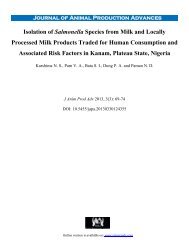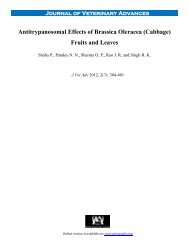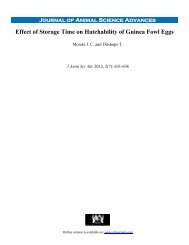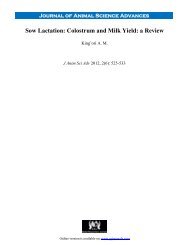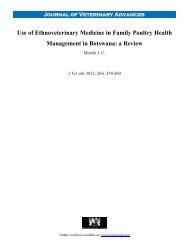Create successful ePaper yourself
Turn your PDF publications into a flip-book with our unique Google optimized e-Paper software.
KING’ORI<br />
within the shell gland area of the oviduct for a<br />
longer than normal period. During this time a very<br />
thin layer of extra calcium is deposited on the egg,<br />
producing a greyish, bleached outlook (Thear,<br />
2005). Release of stress-related hormones will<br />
result in the production of pale brown-shelled eggs<br />
(Hughes et al., 1984). Relocation, such as<br />
movement from one type of housing to a completely<br />
new housing environment, stresses the hens and can<br />
produce severe visual defects of the egg. It is known<br />
to increase the incidence of calcium coated and<br />
checked (misshapen) eggs.<br />
Internal defects<br />
These include defects on the yolk and albumen.<br />
Assessment of Interior egg quality involves<br />
breaking the egg to inspect its contents. Two<br />
interior measurements in common use are the<br />
measurement of yolk color using the Roche Yolk<br />
Color Fan, and the measurement of Haugh units<br />
which also characterize the freshness of an egg<br />
(USDA, 2000; Or-Yehuda, 2007). The Roche Yolk<br />
Color Fan has 15 sample colors, ranging from 1 (the<br />
lightest) to 15 (the darkest), which are visually<br />
matched to the color of the yolk. Internal egg<br />
deffects occur in the form of blood and meat spots,<br />
double yolks, mottled and discoloured yolks, rotten<br />
eggs, watery whites, discoloured whites and round<br />
worms in eggs (Optimum egg quality, 2010).<br />
Occurrence of blood and meat spots is revealed by<br />
candling. Candling reveals most of the spots, but<br />
brown eggshell hampers selection in brown chicken<br />
lines. Estimated frequency of blood and meat spots<br />
in brown layers is about 18% whereas it is 0.5% in<br />
white egg layers (Honkatukia et al., 2011). Several<br />
factors are known to increase the incidence of meat<br />
and blood spots: genetic background, low level of<br />
vitamin A and/or D, stress or infections. Internal<br />
egg quality involves functional, aesthetic and<br />
microbiological properties of the egg yolk and<br />
albumen. Meat and blood spots in addition to being<br />
an aesthetic and ethical problem, they may increase<br />
the risk of infections such as salmonella (Smith et<br />
al., 2008) and reduce hatchability of eggs<br />
(Bermudez et al., 1993). Blood spots are droplets of<br />
blood found usually on the surface of the yolk<br />
(Shirley, 1965). Meat spots appear as red, brown or<br />
white spots in the albumen. They are either pieces<br />
of tissue from reproductive organs or blood spots<br />
that have changed colour due to dilution. They<br />
emerge during the ovulation process in the ovary or<br />
later in the oviduct. Blood on the yolk originates<br />
from bleeding of the small vessels in the ovary or in<br />
the oviduct (Shirley, 1965). Meat spots in the<br />
albumen can be formed from a bit of reproductive<br />
tissue while the egg is passing through the oviduct.<br />
As an egg ages, the yolk takes up water from the<br />
albumen, which in turn dilutes blood spots and<br />
makes them look like meat spots. In general the<br />
frequency of blood and meat spots is less than 1%<br />
in all eggs laid in commercial lines (Smith et al.,<br />
2008). The incidence of spots seems to increase<br />
when the hen ages (Bustanyet al., 1987). Increased<br />
frequency also appears at the start of laying.<br />
Different factors, including nutritional,<br />
environmental and heredity, trigger the incidence of<br />
spots. Probably the most important nutritional factor<br />
is a lack of vitamins A and D (Sauter et al., 1975;<br />
Bermudez et al., 1993; Sutcliffe et al., 1998). When<br />
the supply of vitamin A is sufficient, the chicken<br />
has a low probability of having blood spots (Becker<br />
et al., 1973). Environmental factors, like sudden<br />
loud noises, temperature changes and infections,<br />
induce an increase in the incidence of spots<br />
(Campo, et al., 1998; Deaton, et al., 1986).<br />
Double Yolk eggs appear when ovulation<br />
occurs too rapidly, or when one yolk somehow gets<br />
stuck before shelling and is joined by the next yolk<br />
(2011 PoultryHelp.com). Double yolk eggs may be<br />
laid by a pullet whose productive cycle is not yet<br />
well synchronized. They're occasionally laid by a<br />
heavy-breed hen, often as an inherited trait. They<br />
are usually bigger than the ordinary (normal) egg.<br />
No-yolk eggs (yolkless eggs) are called "dwarf",<br />
"wind" eggs. Such an egg is most often a pullet's<br />
first egg, produced before her laying mechanism is<br />
fully developed and is usually smaller than the<br />
ordinary egg. In a mature hen, a “wind” egg is<br />
unlikely, but can occur if a bit of reproductive tissue<br />
breaks away, stimulating the egg producing glands<br />
to treat it like a yolk and wrap it in albumen,<br />
membranes and a shell as it travels through the<br />
oviduct (2011 PoultryHelp.com). A double shelled<br />
egg or an egg within an egg appears when an egg<br />
that is nearly ready to be laid reverses direction and<br />
gets a new layer of albumen covered by a second<br />
354 J. Anim. Prod. Adv., 2012, 2(8):350-357




